B2B Sales Funnel Explained: Strategies and Tips for Success
In the bustling world of B2B sales, understanding your customers can feel like navigating a maze. With so many options available and decisions carefully weighed, potential clients wander through various paths in search of the right solution. This is where the B2B sales funnel comes into play—a guiding framework that helps businesses gently escort prospects from mere awareness to becoming loyal buyers.
Picture it as a roadmap that not only highlights each stage of the journey but also illuminates the strategies that can make or break a sale. In this article, we’ll dive into the importance of the B2B sales funnel, uncover effective tactics for each stage, and offer tips to help you fine-tune your approach for success.
A B2B sales funnel is a structured process that guides potential customers from initial awareness of their needs through to becoming paying clients. It is important because it helps businesses effectively manage lead conversion, optimize marketing strategies, and ultimately improve return on investment (ROI) by systematically addressing the complexities of longer sales cycles typical in B2B transactions.
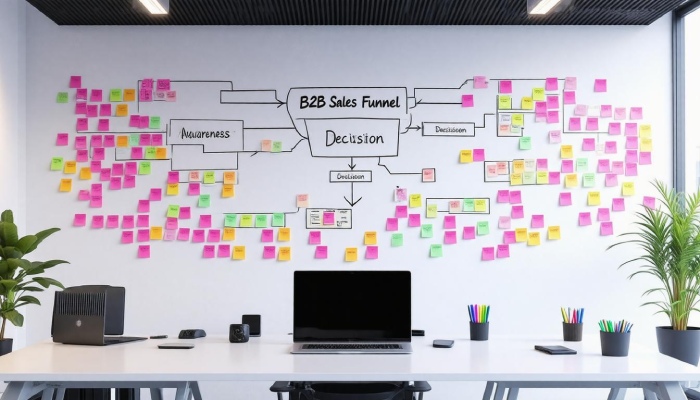
B2B Funnel Basics
The B2B sales funnel is much more than just a pathway; it’s a structured journey that guides prospects from initial awareness of a product or service all the way to making a purchase. One vital aspect to consider is that this journey is not linear and is often accompanied by extensive research and decision-making due to the higher stakes involved in B2B transactions.
Top of Funnel (TOFU)
The top of the funnel, or TOFU, marks the awareness stage where potential clients first encounter your brand. Here, it’s essential to catch their attention using various marketing strategies. Think of engaging blog posts, optimized SEO efforts, and compelling social media campaigns that not only inform but also resonate with your target audience. This is where curiosity begins, prompting them to think, “I need to learn more.”
At this stage, you might wonder how effective your strategy truly is. It’s crucial to utilize analytics tools to gauge traffic and engagement metrics because while attracting attention is an achievement, converting that interest into further exploration is where the real work starts.
Middle of Funnel (MOFU)
Progressing into the middle of the funnel, or MOFU, we enter the interest stage where prospects start actively seeking information about how your offerings can meet their needs. Nurturing leads becomes paramount, which may involve providing valuable resources—like informative webinars, thought-provoking eBooks, or in-depth product articles—that guide prospects toward understanding what sets your solution apart.
Here’s where storytelling plays a powerful role; sharing case studies can effectively illustrate how other clients benefited from your product or service. The aim during this phase isn’t to hard-sell but to foster genuine connections by addressing their unique pain points while building a foundation of trust.
Bottom of Funnel (BOFU)
Finally, we reach the bottom of the funnel—often referred to as BOFU—which culminates in the decision and purchase stage. Here, prospects have gathered extensive information and are evaluating your solution against competitors’. They require compelling calls-to-action (CTAs), attractive sales proposals, and sometimes even free trials or demos as influential factors pushing them toward making a purchase.
It’s vital at this point to ensure every aspect of your communication is customized to address the specific concerns expressed by prospects in prior interactions. Implementing feedback gathered along the way can help tailor your approach, creating personalized experiences that validate their choice and guide them smoothly toward closing the deal.
Recognizing these stages within the B2B sales funnel helps you craft strategies that facilitate initial engagement while nurturing prospects through each phase until they transform into loyal clients.
Developing Effective Strategies
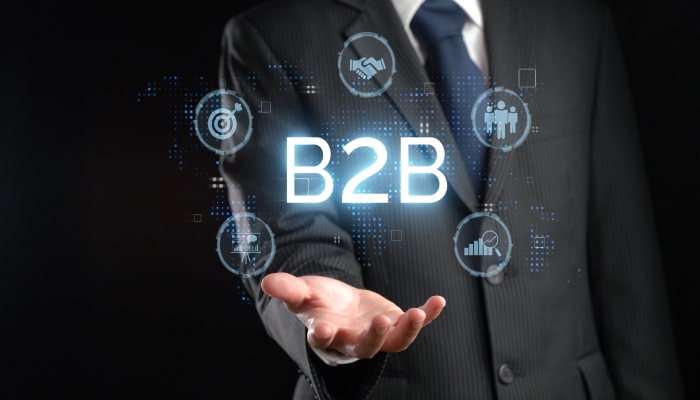
Creating effective strategies for your B2B sales funnel isn’t solely about focusing on numbers or metrics; it’s about weaving together a narrative that resonates with your audience. A successful approach begins with a thorough understanding of your target market while layering multiple tactics to create a cohesive experience.
Implementing a blend of content marketing, email outreach, and strategic social media campaigns can build a reliable touchpoint network for potential clients. Remember, it’s vital to align your sales and marketing teams to ensure a unified front.
Consider the power of Account-Based Marketing (ABM) as one of the game-changing strategies in lower-key sales approaches. Targeting high-value accounts through personalized campaigns allows you to curate specific experiences based on individual needs. Take Salesforce, for instance; they’ve seen significant ROI growth by adopting ABM strategies, demonstrating how tailoring efforts can yield remarkable results.
Strategy Alignment Steps
To lay the groundwork for effective strategies, begin by defining your Ideal Customer Profile (ICP). This entails identifying precise characteristics of companies that would gain the most from your offerings. Knowing who your ICP is helps in crafting strategies that resonate deeply with potential clients. By pinpointing their industry, size, challenges, and goals, you can tailor your message accordingly.
Next, it’s essential to craft tailored messages that speak directly to the pain points of your ICP. By addressing their specific concerns and aspirations through messaging that feels personal and relevant, you’ll cultivate rapport and trust—key components in business relationships. Whether through case studies or thought-provoking insights tailored toward their industry-specific issues, targeted messaging broadens your influence while enhancing engagement rates.
As these strategies unfold, constant evaluation is critical; therefore, implement a plan to measure and adjust your tactics based on performance analytics. Regularly assessing the effectiveness of your marketing campaigns not only enhances your strategy but also informs future initiatives. Metrics to consider include lead conversion rates and overall engagement statistics.
Furthermore, developing feedback loops between your sales and marketing teams can facilitate real-time adjustments and collaborative opportunities. Encourage open communication channels where insights can flow freely between departments, allowing teams to respond swiftly – this will foster innovation while minimizing misalignment in goals. When both teams synchronize their efforts towards a common goal, the entire funnel benefits from increased efficiency and optimized results.
Each step taken to refine these strategies deepens your connection with prospects and ensures you’re not just pushing for sales but building lasting partnerships that contribute significantly to customer retention—a crucial aspect of long-term growth. Transitioning now, we’ll explore how to identify prospective buyers more effectively.
Identifying Prospective Buyers
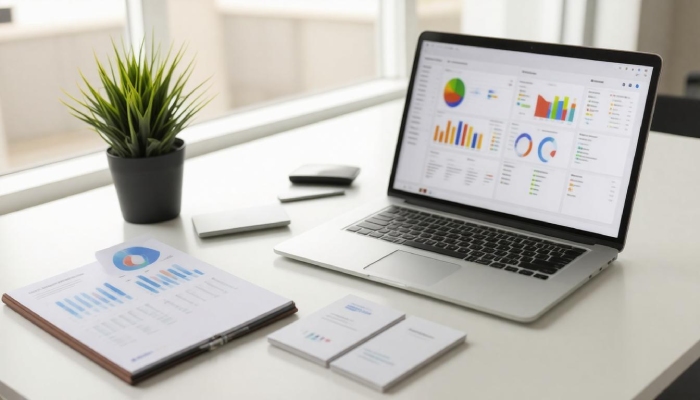
Identifying prospective buyers in a B2B context involves more than generating lists of companies. The focus needs to be on understanding the specific needs and pain points of your target audience, which ultimately requires a tailored approach. This is where your expertise comes into play; by using data-driven insights, you can refine your search for the ideal customer profile (ICP).
It’s essential to utilize a blend of inbound and outbound tactics while employing tools like LinkedIn Sales Navigator. This platform helps you find the right decision-makers within targeted organizations, enabling you to narrow down your prospects effectively. Networking becomes vital at this stage; forging relationships can lead to valuable referrals or insights into potential buyers’ needs.
Outbound Methods
Traditional methods like cold calling and email campaigns can still be effective, especially when combined with tools like CRM systems that personalize outreach and track interactions. A well-crafted message that resonates with the prospect’s challenges will significantly improve response chances. For example, HubSpot found that combining CRM data with cold outreach increased response rates by 50%. This type of personalized interaction can show prospects that you understand their business and the obstacles they face.
It’s also important to recognize the evolving nature of buyer behavior in the B2B landscape. With around 70% of B2B buyers conducting independent research before engaging with sales representatives, your messaging needs to be not only informative but also persuasive enough to cut through the noise. Consider incorporating thought leadership content that positions your business as an expert in solving specific problems faced within your target market.
One should always remember that tailoring your approach according to various buyer personas is critical. This means creating different strategies based on industry, company size, or specific roles within an organization. When your outreach reflects a strong understanding and respect for potential buyers’ unique situations, it fosters trust and lays the groundwork for a long-term relationship.
As we further explore the nuances of identifying prospective buyers, understanding their journey will illuminate what truly drives engagement and conversion throughout each phase of their decision-making process.
Key Funnel Stages
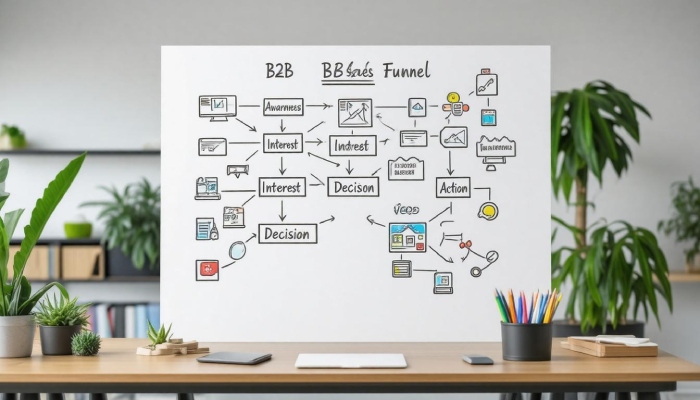
The B2B sales funnel consists of multiple critical stages that guide potential clients from initial awareness to loyalty, helping to convert prospects into long-term customers. Each stage addresses unique aspects of the buyer’s journey, and navigating them effectively can significantly impact conversion rates and overall success.
Awareness
In the Awareness stage, potential customers first learn about your product or service through various marketing channels. This initial encounter often occurs via search engines, social media, or content marketing efforts, such as well-optimized blog posts or informative videos. According to research, 70% of B2B buyers start their purchasing journey with a Google search, highlighting the importance of having an online presence and engaging content that attracts attention.
Once potential customers are aware of your offerings, they transition seamlessly into the next phase: Interest.
Interest
During the Interest stage, prospects seek to explore what you offer to solve their specific challenges. They engage with content designed to inform, such as detailed webpages, product demos, and helpful webinars. It’s crucial to provide resources that address their pain points directly because 60% of B2B buyers prefer content tailored to their specific needs. By showcasing your solutions clearly and effectively, you can keep their interest piqued and prompt them to consider your products more seriously.
Following interest comes the crucial Evaluation stage where comparison becomes king.
Evaluation
In the Evaluation stage, prospects actively compare your solutions against competitors’. This is where value propositions become essential. Clear case studies demonstrating how your products have solved similar problems for past clients can turn the tide in your favor. Here’s where you not only show what you offer but prove its effectiveness through real-world applications.
Nureply can support this process by automating personalized content delivery, ensuring prospects receive relevant material at the right time. Remember, at this juncture, 80% of B2B buyers require at least five pieces of content before confidently making a purchase decision; therefore, ample information must be readily available.
After evaluating their options thoroughly, leads will arrive at the critical Decision stage.
Decision
When prospects reach the Decision stage, they are nearly ready to purchase but need a compelling call-to-action (CTA) that reinforces their choice. This CTA could be a limited-time offer or personalized assistance from your sales team. A strong CTA helps reassure them that they are making the right decision and encourages them to proceed with confidence.
Once they’ve made that decision, we’re ready for the Purchase stage.
Purchase
The Purchase phase marks the moment when prospects officially transition into clients. It’s essential that this initial transaction feels smooth and seamless. Exceeding expectations during this phase lays a strong foundation for what comes next—exceptional customer service should accompany every purchase experience. Ensuring that clients feel supported continues fostering trust in your brand.
After securing a client, it’s important to shift focus toward building Loyalty.
Loyalty
In the final stage of the funnel—Loyalty—the emphasis is on maintaining satisfaction post-purchase. Retaining customers through exceptional service can help turn them into enthusiastic brand advocates who refer others to you naturally. Studies show that improving customer retention rates by just 5% can lead to revenue increases ranging from 25-95%. Thus fostering loyalty not only enhances relationships but also significantly boosts overall profitability.
As you navigate these stages in the B2B sales funnel—Awareness, Interest, Evaluation, Decision, Purchase, and Loyalty—you’ll begin to uncover effective strategies for optimizing successful outcomes at each step while enhancing the overall customer experience.
Content Tactics at Each Stage
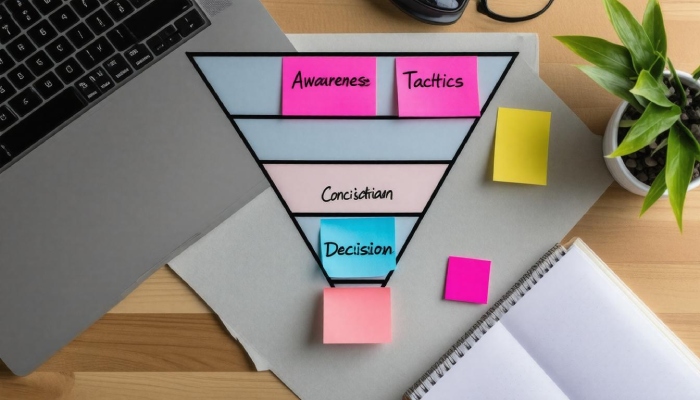
Awareness: Educational Content
At the very beginning, during the awareness stage, you want to create content that resonates with prospective clients before they even realize they need your solution. This is where educational content shines. High-quality blog posts and articles optimized for search engines will draw in visitors grappling with common pain points within your industry.
Imagine someone searching online for strategies to improve their workflow; if they stumble upon your insightful article addressing efficiency tips, you’ve got their attention. Social media updates can also play a pivotal role here, as sharing snippets of this content widens your reach. The goal is to engage potential buyers without pushing specific products—rather, help them understand the challenges they face and how they can tackle them.
Once you’ve captured their attention, it’s time to explore what piques their interest.
Interest: In-Depth Articles and Webinars
As leads transition into the interest stage, they seek more detailed information about possible solutions and how these can address their needs. This is your opportunity to present in-depth articles or whitepapers that provide valuable insights into industry trends or specific issues faced by your target audience.
Incorporating webinars into your strategy effectively facilitates engagement since prospects appreciate interactive content that allows them to ask questions and gain insights directly from experts. To further maximize Return on Investment(ROI), consider implementing gated content—requiring users to share their contact information in exchange for access—thus allowing you to build a list of warm leads who are interested in your offerings.
After drawing in interest, you must guide prospects toward evaluating your solution against others in the market.
Evaluation: Case Studies and Demos
When prospects reach the evaluation stage, they are busy comparing options, scrutinizing features, and looking for proof that your product can deliver real value. Here is where case studies come into play. By showcasing compelling success stories from satisfied customers, you highlight the effectiveness of your solution through evidence rather than mere claims.
Furthermore, offering free trials or demos invites potential clients to experience the product firsthand, bringing clarity and confidence in their purchasing decision. Remember: a well-crafted demo can often speak louder than words.
As prospects move through evaluations and start considering a purchase decision, it’s crucial to simplify any remaining hurdles.
Decision: Clear CTAs and Pricing Pages
Making a decision can be daunting, especially regarding financial commitments. This is why having crystal clear Calls-to-Action (CTAs) alongside transparent pricing pages can significantly impact conversion rates. Prospects should easily comprehend what each tier offers and how it aligns with their needs without feeling overwhelmed by jargon or hidden costs.
Your CTAs should invite prospects clearly towards the next steps—whether that’s signing up for a trial or contacting your sales team for additional questions—guiding them seamlessly through this critical transition.
Once they’ve made the purchase, we shift our focus toward ensuring client satisfaction and long-term success.
Purchase: Onboarding and Support Content
After the decision has been made and prospects convert into clients, supporting them through onboarding is paramount. Providing comprehensive materials that explain how to use your product will not only foster a positive initial user experience but also encourage ongoing engagement with your brand.
Having a dedicated support team available serves as invaluable reassurance during this phase; it lets clients know they have someone ready to assist should they encounter any challenges integrating your solution into their operations. Ensuring a smooth transition solidifies client relationships from the outset and sets long-term loyalty into motion.
By deliberately creating value at each stage with tailored content tactics, you’re not just nurturing leads but also cultivating loyal clients who are more likely to advocate for your brand. Navigating these pivotal interactions lays the groundwork for future engagements focused on tracking progress and refining approaches through thoughtful analysis.
Measuring Success with Metrics

To effectively navigate the B2B sales landscape, it’s imperative to set clear goals and identify the right Key Performance Indicators (KPIs) that reflect those objectives. Think of KPIs as a compass: they guide you through the complexities of your funnel by highlighting areas of strength and those needing improvement.
Perhaps the most crucial metric is the lead conversion rate, which reveals what percentage of leads you’ve successfully transformed into paying customers. A high conversion rate often indicates that your marketing strategies resonate well with your target audience. Conversely, a low conversion rate may suggest that potential customers are losing interest or finding discrepancies between their needs and what you offer.
While these numbers might seem cold, they tell a rich story about your business performance.
Now consider another vital metric: Customer Acquisition Cost (CAC). This figure sheds light on how much you’re investing to bring in new customers, encapsulating all costs associated with sales and marketing divided by the number of customers acquired during a specific period. If you’re spending excessively on acquiring customers but not seeing corresponding revenue growth, it’s time to reevaluate your methods.
Exploring Customer Lifetime Value (CLV)
Building on this idea, we arrive at Customer Lifetime Value (CLV), which represents the net profit attributed to the entire future relationship with a customer. This measurement is invaluable as it helps you predict revenue and understand long-term profitability from individual clients. If you know your CAC but find that your CLV doesn’t justify the expense, adjustments in either acquisition strategy or retention efforts will likely be necessary.
Another straightforward yet significant metric is the average purchase value. This statistic summarizes total revenue divided by the number of orders, giving you insight into purchasing patterns. Monitoring this can help determine if customers tend to buy more during certain promotions or product introductions, allowing for better-targeted marketing campaigns in the future.
| Metric | Definition |
| Lead Conversion Rate | % of leads converted into customers |
| Customer Acquisition Cost (CAC) | Total sales and marketing cost / # new customers |
| Customer Lifetime Value (CLV) | Net profit expected over the lifetime of a customer |
| Average Purchase Value | Total revenue / number of orders |
Regularly analyzing these metrics not only provides clarity into current operations but also allows businesses to make informed projections moving forward.
Incorporating tools like Google Analytics and HubSpot simplifies this process, offering robust tracking capabilities that help visualize these metrics in real time. By transforming raw data into actionable insights, companies can fine-tune their strategies within an ever-evolving marketplace.
Leveraging Technology for Improvement
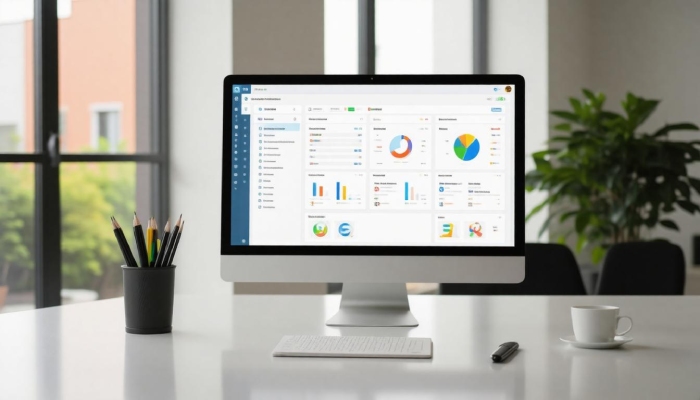
Integrating technology into your sales strategy isn’t just about keeping up with trends; it’s about transforming how you engage with potential customers. For instance, Customer Relationship Management (CRM) systems like Salesforce and HubSpot are at the forefront of this transformation. These platforms not only help businesses manage relationships but also streamline processes, track interactions, and analyze customer data—all under one roof.
Imagine having access to every interaction your sales team has had with prospects right at your fingertips; this gives invaluable context that can greatly enhance follow-up strategies and ultimately lead to higher conversion rates. However, it’s not just about managing data efficiently; it’s also about harnessing the power of automation.
One standout example of effective integration is the use of AI-powered chatbots for initial lead qualification. These digital assistants can engage prospects 24/7, asking pre-set questions and providing immediate responses, so no opportunity goes unnoticed. When a visitor lands on your website at 2 a.m., instead of waiting for morning business hours, they can interact with your bot to get answers to their inquiries.
This means you’re capturing leads even when your sales team is asleep! Moreover, studies reveal that companies employing these AI technologies can experience up to a 20% increase in sales opportunities, as indicated by research from McKinsey.
Beyond AI chats, implementing an integrated tech stack facilitates better communication among team members, allowing for seamless data sharing and collaboration. This connection reduces the time spent on administrative tasks, affording sales representatives more time to focus on nurturing relationships with potential clients.
The decisive factor here lies in ensuring that all tools work harmoniously together, preventing silos or redundant efforts that can drain productivity. The statistic “Sales reps only spend 28% of their time selling,” from Salesforce, highlights a critical inefficiency that technology can ameliorate if implemented correctly.
With the rapid changes in tech landscapes impacting our daily operations, the need for vigilance regarding security and data privacy has never been more pressing.
Emphasizing compliance with data privacy measures is essential in today’s B2B environment, where buyers prioritize security—Gartner states that 46% of B2B buyers prioritize vendor security and certifications. By showcasing your commitment to protecting customer information through transparent practices and compliance procedures, you build trust and strengthen your brand reputation within the marketplace.
Fostering this kind of confidence not only opens doors to new relationships but also enhances existing ones by putting customers’ minds at ease about their personal data.As we venture further into how technology shapes our selling practices, understanding its impact on customer engagement is paramount.
In conclusion, effectively leveraging technology not only streamlines operations but also builds strong customer relationships vital for success in the ever-evolving B2B landscape. Embrace these innovations and watch your business thrive.
What common challenges do companies face when navigating their B2B sales funnels?
Companies often face several common challenges when navigating their B2B sales funnels, including lead generation, maintaining consistent communication throughout the sales process, and effectively nurturing leads. According to industry reports, 61% of marketers say generating traffic and leads is their top challenge, while 68% report difficulties in closing deals due to lack of follow-up or personalization. These obstacles can stall conversion rates and hinder overall sales success if not addressed strategically.
How does content marketing play a role in nurturing leads through the B2B sales funnel?

Content marketing is essential in nurturing leads through the B2B sales funnel, as it provides valuable information that addresses the specific needs and pain points of potential clients at each stage. By delivering relevant content—such as whitepapers, case studies, and blog posts—companies can engage prospects, build trust, and establish authority within their industry. In fact, according to recent studies, content marketing generates three times more leads per dollar spent than traditional marketing methods, showcasing its effectiveness in not only attracting but also converting leads into loyal customers.
What are the main stages of a typical B2B sales funnel?
The main stages of a typical B2B sales funnel include Awareness, Interest, Consideration, Intent, Evaluation, and Purchase. In the Awareness stage, potential clients become aware of your solutions, followed by Interest where they engage with your content. During Consideration, prospects compare options, leading to Intent as they express a desire to buy. The Evaluation stage involves decision-making discussions, culminating in the Purchase stage where the deal is closed. Research shows that companies with a structured sales funnel can increase their conversion rates by up to 25%, highlighting the importance of each stage in maximizing sales success.
How can businesses measure the effectiveness of their B2B sales funnel?
Businesses can measure the effectiveness of their B2B sales funnel by tracking key performance indicators (KPIs) such as conversion rates at each stage, average deal size, and sales cycle length. For instance, a study found that companies with well-defined funnels achieve 50% higher sales conversion rates than those without. Additionally, using tools like CRM software allows businesses to analyze lead sources, identify bottlenecks, and gain insights into customer behavior, enabling data-driven adjustments that enhance overall performance.
What are some effective strategies for moving prospects from one stage of the B2B sales funnel to another?
To effectively move prospects through the B2B sales funnel, prioritize personalized communication and nurturing campaigns. Utilizing data-driven insights allows for tailored messaging that addresses specific pain points, leading to higher engagement. Implementing strategies such as targeted email marketing and content that resonates with each stage of the buyer’s journey can boost conversion rates significantly; studies show that businesses that personalize their marketing see a 20% increase in sales opportunities. Additionally, leveraging social proof like testimonials and case studies helps build trust and credibility, encouraging prospects to advance closer to a purchase decision.







